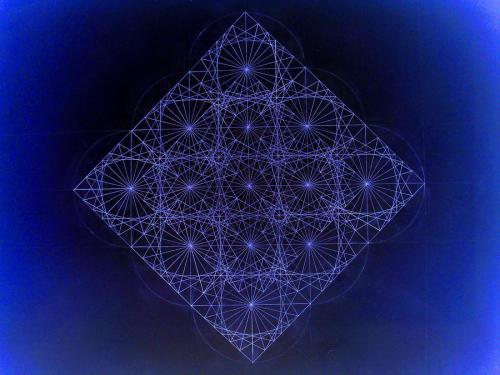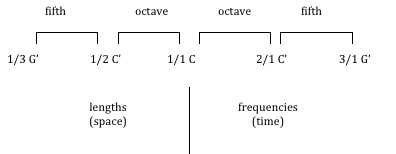“All the creative work of the universe lies in unlimited harmony.”
STRING LENGTHS – WAVELENGTHS
String lengths demonstrate the space aspect of the sound process. The monochord represents them in the simplest and most evident way. But every musical instrument makes use of its own spatial aspect: the length of the column of air in the flute and in wind instruments in general; the thickness of bells, and so on. One can say that for musical instruments the spatial aspect is an inevitable presupposition. High sounds require shorter strings, columns of air and oscillating instruments; low sounds require longer ones.
Let us speak in general of “string lengths” to denote this aspect of sound, as the acoustic spatial laws can be best examined by means of string lengths; hereafter we will reserve this expression to indicate the space aspect of harmonic theorems.
***
In Physics, this same aspect of any process of oscillation goes under the common name of “wavelength”. Besides sound waves there exist very many other waves: optical, electromagnetic, radio, telluric and water waves, etc. They are all measured with spatial instruments and, as far as observing them is concerned, they belong in the same category as sound waves.
The frequencies (that is the number of oscillations), which we will discuss in the next paragraph and which have a temporal character, are obviously coordinated to rhythm; the string lengths, on the other hand, do not immediately make an impression by rhythm and movement, but by their presence, form and figure. However, it is sufficient to represent any kind of waves graphically to derive a clear impression of rhythm from them. This “figuration” of the rhythm confers a special significance, in the sphere of Harmonics, on the phenomenon of the “string length”.
Observations of this kind have little sense for Physics, which seeks on the contrary to make no distinction between wavelength and frequency, through common and reciprocal formulae for both “aspects”, which make it possible to pass from one to the other. That this reciprocity is also of the greatest importance in Harmonics we shall soon see. But for Physics it has only a value of calculation and everything simply depends on whether the phenomenon is observed from one or other of the two aspects: space or time.
“When the spirit assimilates the forces of the Magnet for thousands of years it becomes supreme harmony itself.”
NUMBER OF OSCILLATIONS – FREQUENCY
The number of the oscillations – called frequency in Physics – manifests the time aspect of the sound process. It is no longer a question of the string length, or of the column of air, or of the dimensions of the bell, but of their oscillation in the unit of time.
The oscillations of a sound are regular, that is they succeed each other, the tone being equal, always with the same interval of time or, which is the same thing, with the same rhythm. High sounds have greater frequencies (faster); low sounds have lesser frequencies (slower).
***
The physical unit for frequencies is called the Hertz and is equal to 1 oscillation per second. We will not use it because, in expounding the various theorems, it is sufficient to mention simply the frequency.
As regards the experimental representation of the sound frequencies, the problem is much more complex than for the lengths, which are shown with so much simplicity through the monochord. It is clear that the direct measurement of the oscillations in the unit of time is not easy, since they are so rapid just for medium sounds that the eye cannot assess them. Various indirect methods, especially electronic ones, exist today which allow an approximate measurement of the pitch of a sound, yet they are all rather costly and complex. But in Harmonics they are not necessary, since, as we shall see, the sound frequencies are reciprocal (that is in inverse relationships, like 2/3 or 3/2) to the wavelenths and therefore, with a simple “inversion”, one can always find the corresponding length on the monochord.
“As a magnetic wave gathers different currents, so the harmonized spirit has the capacity to gather those streams which lead to the eternal power of Being.”
RECIPROCITY BETWEEN WAVES AND FREQUENCIES (SPACE AND TIME)
Having discussed the spatial and temporal aspect of the sound process in the last two paragraphs, let us see what relationship connects them. A short reflection is sufficient to notice that we are considering two factors of immense importance which underlie the phenomenon of sound. What do we know of space and time? We have a sense of both of them (in space “we are”, in time “we become”), but if we want to give a mental form to these sentiments, we find that the two concepts have no relationship and are foreign to each other and each one belongs to its own world. It is clear that everything is contained in space and that everything becomes in time. Nobody, however, can isolate these two concepts: while combining them presents no difficulty, since in effect we, together with the whole of Nature, live in a space-time dimension.
Yet with these considerations one just recognizes a fact.
So in what relationship are space and time? What form does space assume in time, and the latter in the former? This problem is as old as philosophy. But here it is not a question of the philosophical aspect, but of the phenomenon of reciprocity between time and space revealed by the study of oscillations, which is most obvious precisely in Acoustics. It is a question of such importance that it must be examined with great attention.
Let us start with the space aspect (lengths), taking the free string as equal to 1 C and seeking the higher octave C’. We obtain it by halving the string (1/2) and, if we divide it into three (1/3), we hear the interval of a fifth.
Let us now ask what frequencies (time) these same sounds have. After physical experimentation, it is found that the higher octave doubles (2/1) and the fifth trebles (3/1) the frequency of the free string (1/1).
As can be seen, whether their origin is spatial or temporal, the sounds and intervals are in perfect reciprocity, that is, the higher octave, c’, is expressed with the fractions 1/2 and 2/1, and the fifth with 1/3 and 3/1. But this reciprocity is surprising if we examine its form. The double series, when developed, is written thus:
1/n ← 1/4 1/3 1/2 1/1 2/1 3/1 4/1 → n/1
space time
and shows that the left (or “spatial”) branch has quite a different aspect from the other: which is still more obvious if we represent them according to geometrical sizes:
The reciprocity between space and time thus has, like Janus, a double face and presents two forms, measurable but different: the temporal succession, which has characteristics of uniformity and equidistance, and the spatial one, which is not uniform and serial and is composed of points which come closer and closer to each other in perspective.
All this is valid, however, only if the string is divided into two, three or four parts – in brief, when we act in the direction of making the space aspect smaller. If, on the other hand, we double, treble, etc. the initial string, that is, we hear the lower octave, fifth, etc. the figure is reversed:
The two series then assume this expression:
n/1 ← 4/1 3/1 2/1 1/1 1/2 1/3 1/4 → 1/n
space time
To sum up: if we increase the lengths, the temporal aspect “contracts”, while the spatial one remains uniform and equidistant. If on the other hand we diminish the lengths, the space “becomes shorter” and the time remains uniform. It is a phenomenon of great importance, from whichever side one looks at it.
It must be said, naturally, that the same relationships, and the reversed ones, are obtained if the frequencies are taken as the basis. The sounds obtained are then complementary: F becomes G, As (A sharp) becomes E, etc.
In other words, for an observer immersed in a uniform, “equidistant” and “Euclidean” space, time will be unequal, in perspective, with closer and closer intervals. If, on the contrary, he is in a uniform temporal flow, the space, in which that time transpires, must become “perspectival” and “non-Euclidean” (that is, where the parallel lines meet).[1]
The reciprocity between time and space, as one reads in any text of physics, is not the special concern of Acoustics, but is a general property of any oscillation. Harmonics, however, is the only science which is able to express this phenomenon in a psychic sense – a fact which validates consideration of the space-time problem in terms of harmonics.
It is amazing that Physics has not pointed out the surprising form of this reciprocal relationship and has limited itself to the numerical expression 1/n : n/1. Otherwise it would not have failed to note the correspondence that it has with the famous “contraction of Lorentz” in the Theory of Relativity.
With this theory, the analogy is evident, especially as regards the famous paradox of Einstein, that is, that the world is “finite” and nevertheless “unlimited”. To illustrate it, one resorts usually to the example of a sphere, on the surface of which one can crawl “without limits”, even if it is a finite space. If instead of this example one were to use the concept of reciprocity between time and space
0 = 1/∞ finite 1/3 1/2 1/1 2/1 3/1 unlimited ∞/1 = ∞
time (or space) ┴ space (or time)
one would have, to begin with, the advantage of making use of a physical property and also of revealing the morphological foundation of that paradox: it is probably a question not of a simple spatial question, but spatial-temporal, in which one vector is labelled as unlimited and the other as finite.
Another analogy emerges from the foregoing, especially if one observes, on the one hand, the convergence and, on the other, the divergence of the two reciprocal series:
1/∞ … 1/4 1/3 1/2 1/1 2/1 3/1 4/1 … ∞/1
finite ┴ unlimited
Since ancient times, the study of matter in the microcosm has sought a limit in the last indivisible particle (the atom). That is accepted as a likely hypothesis and, on the other hand, considering the macrocosm as a space without limits presents no difficulty. This is really surprising and one can only explain it by supposing that a prototype scheme exists in us, according to which that which is limited is small (1/∞) and that which is unlimited is large (∞/1).
One can raise the objection, in this regard, that the mathematical expression 1/∞ is not limited, that is, the series which tends towards this value is not convergent but divergent. This, however, is valid only in a purely logical-mathematical sense. For, if one represents it in some geometrical way, for example by drawing segments successively equal to 1, 1/2, 1/3, and so on, one reaches the conviction quite soon that there is a tendency towards a limit, beyond which one cannot pass; and precisely this prospect, this progressive shortening contrasts with the fact that the other series: 1, 2, 3, … ∞/1 is “really” unlimited. This is without saying that on the “divergence” of 1/∞ well-founded objections can be raised, even in a purely logical sense.
EMERGING CONSIDERATIONS
These brief comments, of an exploratory nature, aim as a whole to prepare the renewal of a superior Harmony, which littlt by little emerges from the depths and is revealed. Already the virtues of Heaven bring it back to earth: but first it must descend into the heart of man, which links the latter to the former.
Light and delicate wings support these uncertain and timid flights. But let the person who follows this commentary prepare himself to carry out other, much loftier and more courageous, flights towards other planets and constellations. He himself will have to fly, in adoration.
This then is not an acquired knowledge, set out in formulae. It is a spatial investigation which does not claim to put together a system. However, it has direction, rhythm and energy.

“The cosmic Breath of the Mother of the World pervades everything. In truth, everything is impregnated with it … life moves and breathes through that Breath.”
Space lives, breathes and vibrates.
So any length, whether physical or not, vibrates by itself; any region, whether circumscribed or not, is pulsating. Consider the various regions, heavenly, earthly, human, forms of geometry, forms of the mind, and all lesser impulses. All this is pulsating and vibrating.
In any point in Space all the infinite possibilities are latent.
Any form in Space is like a “resonator” which, if suited to the aim, emphasizes certain of its particular frequencies, to produce the effects desired by its builder.
“Any form of Space”. It is the introduction of a new and simplifying concept. Space exists, pervaded by Fire. With our senses we perceive forms of forms, that is types and classes of forms. But these are nothing but forms of Space, which yet contains them. However complex a form is, however numerous the ingredients of various kinds are, it can always be reduced to a grouping of forms of Space. Its characteristics enhance Space, whether enclosed or external. Between these two regions, inside and outside, a relationship is established by form.
It is true that any separation is illusory and so the forms are creators of enchantment. But this illusion is still always the Cosmos, the infinite field of our experience.
***
By observing the laws of vibration (or of the cyclical variation of energy), man can make objects, instruments and thoughts suitable for selecting the desired frequencies. The limits of this prodigious faculty are only those imposed by his illusions. With a gesture he can evoke the forces or the humanity of distant worlds; with a thought, emphasize superior frequencies and introduce them as solutions into the environment; with a small object like a vase, or a large one like a temple, place in a state of resonance very powerful, if inaudible, vibrations. With geographical alignments, he can compose vast harmonies between Heaven and Earth and start luminous civilizations. In this he proceeds like Nature, which from within erects forms which enclose and open itself.
Then if his work is harmonic and he seeks celestial harmonies, he lights fires in Space and collaborates with the Cosmos. Beauty is a form not of Space, but of Fire. Thus Space and Fire, united by beauty, reproduce in consciousness the Essence (that is the Tao) which generated them.
***
From this follows the importance of the purity of Space. It is not enough to compose figures according to rules of harmony, to obtain beauty and fire. This operation must be the sum of many others, preceding, following and simultaneous with it. It is not enough to copy the beautiful work of others in order to build in a celestial way. All gestures, thoughts, impulses and motives must be concordant, among themselves and with the universal aim. In this case, certainly, the work of man’s hands, whether tiny or monumental, is lasting and acts in Space with the constructive power of its fire. In this case, its author presents himself as godlike in future epochs, with the authority of a messenger; he prepares, cultivates and composes forms of joy destined for appropriate times.
There are no limits to harmony; otherwise, after the drawing of a rectangle 1 : ½, everything would be completed. The forms of Space which issue from man are the fruit of an ongoing process, which originates in a distant past and passes through the present but is directed towards the future. He expresses what he has with forms; but he can vary its content if he unites his life to that of the Cosmos.











